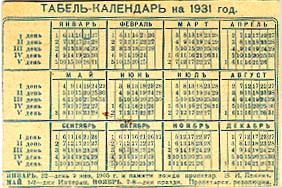FROM a HISTORY of CALENDAR REFORMS in the USSR
In August 1929, by decision of the Council of the National Commissioners of the USSR, was introduced the so-called five day week. Simultaneously with this was introduced a regime of three uninterrupted work shifts. The basis being to achieve the maximal use of industrial equipment, on the one hand, while increasing the quantity of days off. By autumn, the gradual transition to an ìInterrupted working regime" had began, and was completely integrated by the spring of 1930.
Practically, this was the introduction of a new, universal calendar. The working week now represented itself by a so called ìpjatidnevkaî (five-day week) with one day off. Five additional days of a year were holidays and did not enter into the weekly calendar.
Thus, in one year there were 72 five-day weeks and each January 1st began with the first day of the first five-day week. The days of week were referred to as: the first day of five-day week, the second, the third etc. It is clear that to preserve the old names of days of week would result in confusion but introduction of the new names was very complex and rich in confusion. Also in this case, it was necessary to retrain all of the country. It can be suspected that most clever people from the government had counted beforehand that this innovation might appear to short termed.
Unresolved was the question concerning an additional day during leap years. Five-day weeks did not live beyond 1932. By November of 1931, the Council of the National Commissioners of the USSR had accepted the decision, which permitted ministries and other establishments to return to a seven day week or to use a six day week for some works.
However, introduction of a new calendar is an extremely complex thing. There are known only a very few such successful similar attempts in history, such, as introduction of a lunar calendar in the countries of Islam or introduction the Gregorian calendar in the European countries. And all similar successful actions are connected with simultaneous introduction of the new calendar in neighboring countries. An attempt to introduce a "Revolutionary" calendar in France during the Great French revolution was not successful and collapsed.
Five-day weeks in USSR also lasted only a couple of years. The Six-day week calendar lasted a little bit longer until 1940. On one hand, the quantity of days off in one year really had increased, but, on the other hand, these calendars were counter productive to the old habitual calendar which already had worked in the country of centuries. These unusual calendars were badly received by the people, in part because the dates of Church holidays did not coincide with days off. Besides even after introduction of the new calendars, the USSR had to support the old calendar even if just for external relations. Not without reason, all known pocket calendars issued in the thirties were the usual and traditional calendar.

However, still surviving is at least one pocket calendar with a five-day time working week from the year of 1931 and it was double sided. On its one side was printed the traditional Gregorian calendar while on the other a five-day work week calendar.
When confusion lead to a threat to the plans of industrial development and the quantity of days off seemed to the government too large, the six-day work week (just as the five-day work week earlier) was in June of 1940 replaced by the traditional seven day week with a 8-hour working day and a simultaneous with simultaneous prohibition against workers and other employees to leave the enterprise without permission.
But, even though the five day week calendar had existed only 2 years, it left its mark in some Russian films (for example, ìVolga-Volgaî) and in the history of Russian pocket calendars.